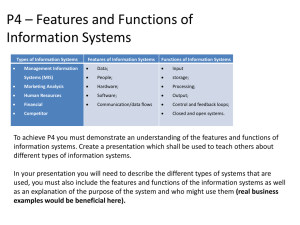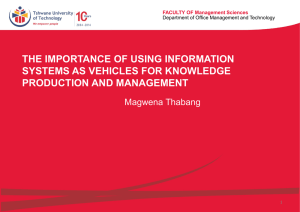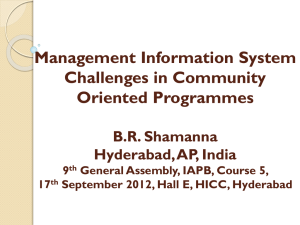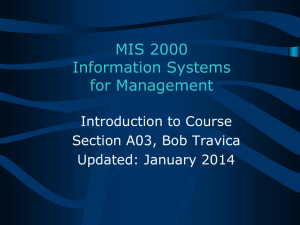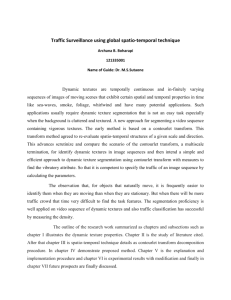IT in Business
advertisement
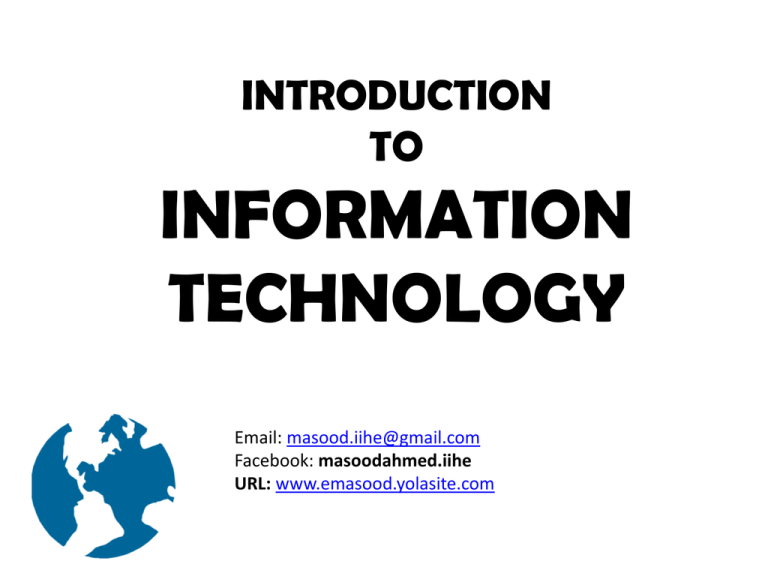
INTRODUCTION TO INFORMATION TECHNOLOGY Email: masood.iihe@gmail.com Facebook: masoodahmed.iihe URL: www.emasood.yolasite.com Recommended Books (1) “Information Technology in Business Principles, Practices and Opportunities” Second Edition By James A. Senn (2) “Management Information System for the Information Age” 4th Edition By HAAG/CUMMINGS/ MCCUBBERY Timeline of Technology Evolution Human history has been shaped by three dynamic advances or waves of transformation. 1st Wave: Agricultural Age 8,000 B.C. 2nd Wave: Industrial Age 1750 3rd Wave: Information Age 1955 2011 ? Agricultural Age Agricultural Age begins around 8,000 B.C. and runs through the mid1700s. This wave is characterized by trade and basic training-based education, daily life and traditions organized around the seasons simple technology with tools made from stone or metal, wood were made from natural materials. Agricultural Age 8,000 B.C. 1750 1955 2011 ? Complex machines evolving from simple machines Pulley Lever Beginning of the industrial revolution 1712 - Steam Engine 1733 - Flying Shuttle, Automation of Textile The automation of making The first steam engine on top of a textiles (fabrics, clothing, etc) water filled mine shaft and used it marked the beginning of the industrial revolution. to pump water out of the mine. The Industrial Age The Industrial Age occurs between 1750 and 1950, continuing through to the mid-1950s. This age is characterized by People leaving the farms for work in the cities, mainly in factory and industry jobs, Great advances in the areas of communication and technology with the invention of the three Ts (Telegraph, Telephone, and Television) along with the first computers. Industrial Age Agricultural 8,000 B.C. 1750 1955 2011 ? The Information Age The period in which the majority of workers are involved in the creation, distribution, and application of information. It is further characterized by Development of a literate workforce, Computerization resulting in major changes in business management and operations. Informatio n Age Agricultural 8,000 B.C. Industrial 1750 1955 2011 ? The Digital Revolution J Information Age/ Digital Age/ Information Superhighway/ Internet Revolution “The change from analog mechanical and electronic technology to digital technology that has taken place since 1980s.” Information Technology Facts presented in a meaningful fashion. A set of tools that enables us to work with information Hardware •Input devices •Output devices •Telecommunication devices •Storage devices Software •Application software e.g.MS-office S/W, media software, business software •System software e.g. operating system software, utility software Personal Computers Wireless Networks Satellites Cellular technology videoconferencing Internet Information Technology Technical definition: “The capability to electronically input, process, store, output, transmit, and receive data and information, including text, graphics, sound, and video, as well as the ability to control machines of all kinds electronically.” Information Technology ITAA Definition: “The study, design, development, implementation, support or management of computer-based information systems, particularly software applications and computer hardware." Components of Information System PEOPLE knowledge worker • A knowledge worker works with and produces information about a product. • When you graduate, you will start working as a knowledge worker. EXAMPLES: • Professionals like teachers, lawyers, architects, physicians, nurses, engineers and scientists Components of Information System PEOPLE Who is not knowledge worker? • The counter attendants at McDonald’s are not knowledge workers. They enter the details of your order into a computer terminal. These details are used by knowledge workers to manage inventory, order supplies and schedule workers. Components of Information System PEOPLE Telecommuting • The use of communication technologies (such as the Internet), to work in a place other than a central location. • Telecommuting is a wonderful concept for increasing quality of life and earning opportunities for otherwise unemployed people. Information Technology Embedded Information Technology “The information technology that is integrated with the other components of products and services, giving it new features and capabilities.” Embedded Information Technology At travel agent office On the aircraft Autopilot system EMBEDDED INFORMATION TECHNOLOGY At the airport At Hotel Ease passenger check-in, baggage handling, onboard services etc. Maintain traveler’s preferences, payment details etc. Maintain profile of customers such as seating requirements, payment details etc. At the auto rental agency Maintain client’s preferred automobile features What is Data? Definition: “A collection of raw facts that describes a phenomenon” Examples – Current temperature – Price of a movie rental – Your age etc. What Is Information? Definition: “Data that has been processed, manipulated and organised in a way suitable for human interpretation” • If you are trying to decide what to wear, the current temperature is information because it is logical help to your decision. What Is Knowledge? Definition: “An awareness and understanding of a set of information and how that information can be put to the best use.” • Information adds to the knowledge of the person receiving it. Data Vs. Information • Data is the raw material – the input of information • The word information is derived from Latin informare which means "give form to". CHARACTERISTICS OF USEFUL INFORMATION For information to be useful, it must be… •Relevant – -----within the context •Simple ------- --understandable •Complete –-- --including all needed •Accurate – -----error free •Current – ------not out-dated •Secure ---------- free of •Economical –--cost does not exceed than the value of information •Timely – -------available when needed •Accessible - ---all those who need the information can get to it contamination •Reliable --------results are consistent Benefits of IT Benefits of IT Speed • Computers can perform complex calculations, recall stored information, transmit information from one location to another in a split of a second. Consistency • A computer can perform a task the same way every time. Benefits of IT Precision • Computers can detect minute differences that people can not see. • In automobile manufacturing embedded computer system helps precise placement of a part. Reliability • Reliability comes with speed, consistency and precision MIS Management Information System Management Information System (MIS) General definition: “MIS or simply IS (information system) is a combination of hardware and software and telecommunication used to process information automatically.” MIS---Examples • Online bill payment system at a bank • A support website of a product • Computer system used to process orders for a business Management Information System (MIS) Technical definition: “MIS deals with the planning for, development, management, and use of information technology tools to help people perform all tasks related to information processing and management.” COMPONENTS OF MIS • • • • • • People Hardware Software Procedures Telecommunication Database Components of Information System PEOPLE – The components that most influence the success or failure of information system. – People means end users, those who are using computers . • • • • • • • Systems Analyst Programmer Technician Engineer Network Manager MIS (Manager of Information Systems) Data entry operator Components of Information System HARDWARE – any of the physical equipment in a system. Examples include screens, printers, computers, telephone wires, etc. SOFTWARE – a list of instructions that guides the hardware in the performance of its duties (Components of Information System) DATA • Data are distinct pieces of factual information used as a basis for reasoning; a fact; a number, a statement, or a picture, discussion, or calculation INFORMATION • The data that have a particular meaning within a specific context. Components of Information System PROCEDURES – Refers to rules or guidelines people follow when using software, hardware and data. – Documented in manuals written by computer analysts. – Provided by software/hardware manufacturers of the product. – A procedure can be quite complex and involved, such as performing a backup, shutting down a system, patching software. Components of Information System TELECOMMUNICATION • Allows computers to connect and to share the information with other users(computers). Components of Information System DATABASE • A database is a structured collection of records or data that is stored in a computer system. • Traditional databases are organized by fields, records, and files.



